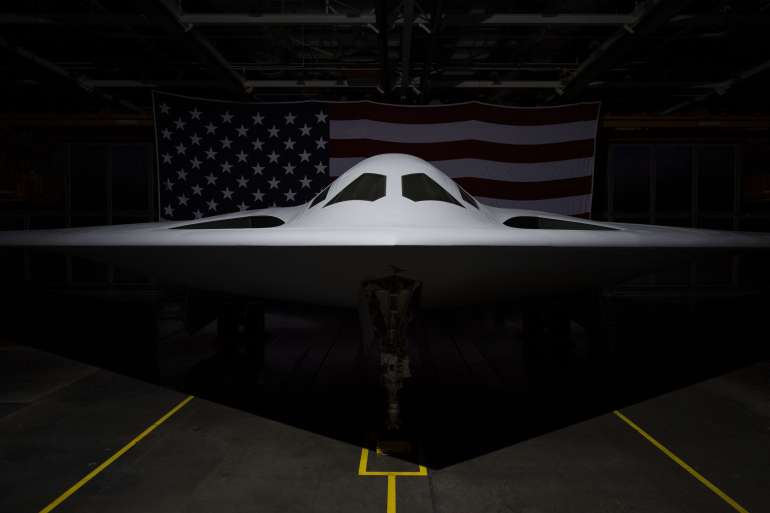The secret’s out: Pentagon unveils its newest stealth bomber

Orchestra music swelled, and the bomber was towed out of the hangar. The sheet fell away to reveal a flying wing similar to the B-2 — the Air Force’s last bomber, unveiled in 1988 — but slightly smaller, its inlets more flush to the body of the jet, likely for greater stealth.
“America’s defense will always be rooted in deterring conflict,” Austin said moments later. “So, we are again making it plain to any potential foe: the risks and costs of aggression far outweigh any conceivable gains.”
A crowd of Northrop employees who worked on the B-21 program chanted “USA, USA” as the ceremony ended.
The B-21 has been shrouded in secrecy since the Air Force chose Northrop over Boeing to build the plane in a hotly contested competition in 2015. Unlike other classified programs, the Pentagon openly acknowledges the new bomber’s existence — but that’s about it. The Air Force has kept most information about the plane a secret so that potential adversaries such as China and Russia cannot steal its design or develop ways to shoot it down.
What the public does know is that the B-21 is built with a new generation of stealth technology designed to evade the most sophisticated radars. Austin touted the fact that “50 years of advances in low-observable technology have gone into this aircraft.”
“Even the most sophisticated air-defense systems will struggle to detect a B-21 in the sky,” he said.
The bomber is designed to penetrate enemy air defenses and reach targets anywhere in the world — something only about 10 percent of the current bomber force can do, according to Northrop. The B-21 is more efficient than any other long-range bomber in the world, Austin said, noting that “it won’t need to be based in-theater, and it won’t need logistical support to hold any target at risk.”
“Having a capability like this is important for deterrence and for being able, if we need, to prevail in conflict,” said a senior DoD official, who was granted anonymity to discuss a sensitive topic, ahead of the ceremony.
This will be particularly important if the U.S. gets into a conflict with China, which has dramatically expanded its military capabilities over the past decade. For example, if China decides to invade Taiwan — a scenario the Pentagon estimates could happen by 2027 — the B-21 would be able to respond on short notice, said Mark Gunzinger, an analyst with Center for Strategic and Budgetary Assessments.
The B-21 is “the China deterrence bomber,” Gunzinger said, speaking on a panel at the Air Force Association’s annual conference in September.
The Air Force plans to buy at least 100 B-21s to replace its fleet of B-1 and B-2 stealth bombers, with the first deliveries of the aircraft expected in the mid-2020s. It will be able to carry both nuclear and conventional weapons and will have the ability to be manned or unmanned, Northrop says.
Carrying a range of munitions “with formidable precision” will allow the B-21 to support operations across “the full spectrum” of warfare, Austin said, much like the Air Force’s current bombers. The B-52, for example, has dropped conventional bombs on Islamic State targets in Syria and can also carry nuclear weapons if such a conflict arose.
The Raider is also “multi-functional,” Austin said. “It can handle anything from intel gathering to battle management to integrating with our allies and partners.”
The B-21 has been designed with an “open architecture,” allowing the Air Force to swap out older systems more easily for new technologies. This approach was adopted to help prevent the bomber, which was initially designed almost a decade ago, from becoming obsolete amid rapid technological advances.
“So as the United States continues to innovate, this bomber will be able to defend our country with new weapons that haven’t even been created yet,” Austin said.
Unlike many recent military aircraft programs, most famously the controversial F-35 fighter jet, the new bomber has stayed on cost and on schedule. The Air Force has set a $500 million ceiling for the unit cost in 2010 dollars; in 2019, Northrop said the Air Force’s target cost would be just over $600 million, accounting for inflation.
Over the next few months, the B-21 will undergo additional testing to make sure it is ready for its first flight, which Northrop has said will likely occur in 2023.
The Raider is named for the Doolittle Raiders, known for their surprise attack on Japan during World War II. To pick the name, then-Air Force Secretary Deborah Lee James and then-Air Force Chief of Staff Gen. David Goldfein put out a call for submissions and chose from a list of thousands of options that ranged from the ridiculous — “Sneaky McBombFace” — to the ominous — “Black Death.”
The first new B-21s will be based out of Ellsworth Air Force Base in South Dakota, and formal training will be conducted there as well. Maintenance and sustainment will be handled at Tinker Air Force Base in Oklahoma, while testing and evaluation is being performed at Edwards Air Force Base in California.
Other prime contractors include Pratt & Whitney, which provides the engine; BAE Systems, which is most likely building the electronic warfare system; GKN Aerospace; Janicki Industries; Orbital ATK, which was acquired by Northrop; Rockwell Collins; and Spirit AeroSystems, according to Byron Callan, an analyst with Capital Alpha Partners.